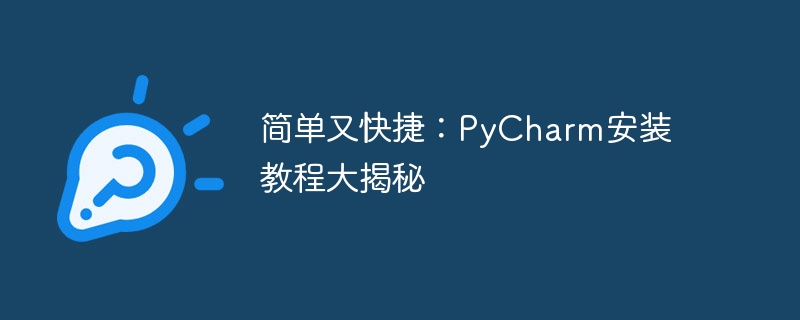

Simple and fast: PyCharm installation tutorial revealed
PyCharm is a very popular Python integrated development environment (IDE), which provides a wealth of functions and tools , which facilitates developers to write, debug and manage Python programs. This article will introduce you to the installation steps of PyCharm in detail and provide specific code examples to help you quickly master the installation method of PyCharm.
Step One: Download PyCharm
First, you need to go to the JetBrains official website (https://www.jetbrains.com/pycharm) to download the PyCharm installer. PyCharm has two versions to choose from: Community version (free) and Professional version (paid). Choose the appropriate version to download based on your needs.
Step 2: Run the installation program
After the download is completed, double-click the installation program and follow the prompts to complete the installation program. During this process, you can choose the installation path, create a desktop shortcut, and other options. Just choose according to your needs.
Step 3: Start PyCharm
After the installation is complete, you can start PyCharm through the desktop shortcut or the PyCharm icon in the start menu. The first time you start PyCharm, it will ask you if you want to import your previous settings and plugins. If you have installed PyCharm before and want to keep your previous settings, you can choose to import.
Step 4: Create a new project
Once PyCharm has started, you will see a welcome interface. On this interface, you can choose whether to create a new project. Click the "Create New Project" button, and then follow the prompts to enter the name of the project and the storage location.
Step 5: Set up the Python interpreter
After creating the new project, you need to set up the Python interpreter. PyCharm can automatically detect the Python interpreters installed on your system and provide you with a choice. If you have not installed the Python interpreter, you can click the "Configure Interpreters" button to install it.
Step Six: Write Code
Once the project is created and the Python interpreter is configured, you can start writing Python code. On the main interface of PyCharm, you can see a code editing area where you can write and edit Python code. In addition, PyCharm also provides many additional functions, such as automatic code completion, syntax checking, code debugging, etc., which can greatly improve programming efficiency.
The following is a simple code example:
# 计算斐波那契数列的前n项
def fibonacci(n):
if n <= 0:
return []
elif n == 1:
return [0]
elif n == 2:
return [0, 1]
else:
fib = [0, 1]
for i in range(2, n):
fib.append(fib[i-1] + fib[i-2])
return fib
n = int(input("请输入要计算的项数:"))
result = fibonacci(n)
print(result)The above code implements the function of calculating the first n terms of the Fibonacci sequence. You can create a new Python file in PyCharm, copy and paste the above code into the file, and run the code to observe the results.
Through the introduction and sample code of this article, I believe you have mastered the installation steps and basic usage of PyCharm. PyCharm's powerful functions and friendly interface make Python development work easier and faster. I hope this article is helpful to you, and I wish you better development results when using PyCharm!
The above is the detailed content of Quick and easy: PyCharm installation cheats exposed. For more information, please follow other related articles on the PHP Chinese website!
 How to change pycharm to Chinese
How to change pycharm to Chinese
 pycharm installation tutorial
pycharm installation tutorial
 How to solve the problem that pycharm cannot find the module
How to solve the problem that pycharm cannot find the module
 How to install pycharm
How to install pycharm
 The difference between python and pycharm
The difference between python and pycharm
 How to configure the pycharm environment
How to configure the pycharm environment
 How to install the pycharm interpreter
How to install the pycharm interpreter
 What does pycharm mean when running in parallel?
What does pycharm mean when running in parallel?




